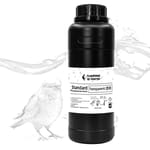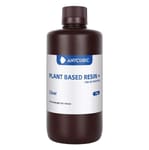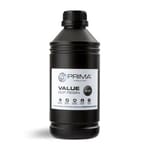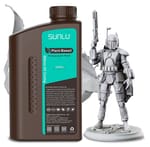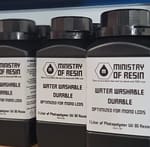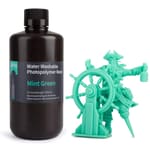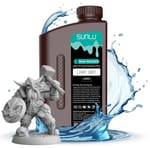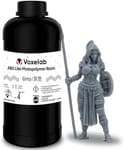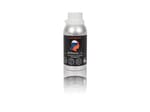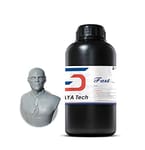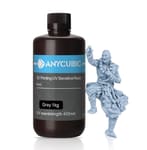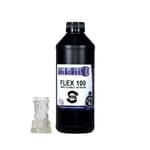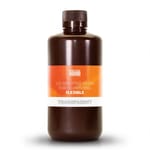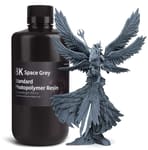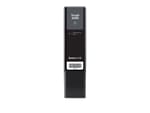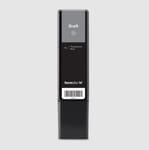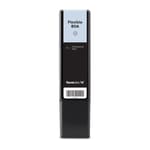It’s been a few years since the first affordable desktop resin 3D printers hit the market, and the offerings of both printers and resins have only increased since then. If you’re a newcomer to resin 3D printing, it can be a bit confusing and even overwhelming to find a suitable resin for your printer and specific project.
Resin printers are famous for the high level of detail they can attain, which is why they’re popular for printing miniatures and jewelry. Additionally, they can be used in certain industries like dental, which require highly accurate molds or prints.
Broadly speaking, resin is a liquid material that reacts with UV light, causing it to solidify. It is formulated with monomers (which form polymers), oligomers, and additives, which manufacturers are rather secretive about. These ingredients cure into a solid photopolymer with exposure to light.
Because of their chemical composition, it’s important to ensure safety when working with resins. A mask and gloves are always recommended, as resins emit toxic fumes and aren’t good for your skin, especially with prolonged contact.
In this article, we’ll go over the most common types of resin while also presenting some popular options for each category. But first, a bit more on resins.
Choosing the Right Resin
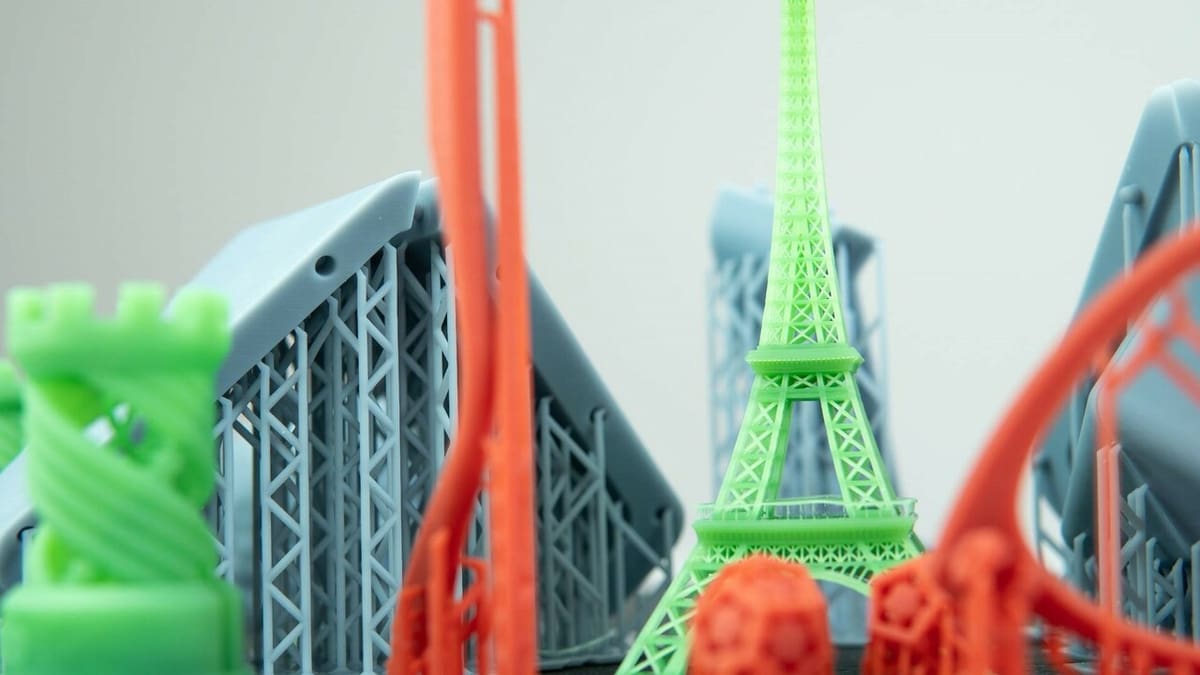
Most resin 3D printer manufacturers include a bottle of resin alongside the machine, but once that (often small) sample is gone, the question arises: which resin should I get?
If you’re a beginner in resin 3D printing, the most sensible decision is to go with the resin made by the printer’s manufacturer. This will make it easier, as manufacturers often provide print settings that are proven to work with the specific hardware and resin combination. However, there are other resin manufacturers that produce amazingly good products, so it’d be a real shame not to try those, especially if you’re after some special options.
Once you start researching resins, the range of options and variety of information can quickly become overwhelming. Numbers on spec sheets aren’t always enough, so in making our selection of the best options, we’re also taking into consideration our own experience and makers’ reviews.
The main types of resin include standard, water-washable, tough, draft, flexible, and high-resolution 8K. We’ll go over the aspects you should be aware of for each, as well as our top picks of brands.
It’s important to keep in mind that there are multiple resin 3D printing technologies available, such as LCD, DLP, and SLA, and not every resin works optimally with each of these. In order to avoid confusion, we’ve first listed the products that are specifically compatible with LCD and DLP printers, and at the end, we’ve also grouped together proprietary SLA resins.
With that in mind, let’s go ahead and explore the world of 3D printing resin. Note that some brands sell resin by weight and others by volume, so for comparison purposes, 1 kilogram of resin is approximately equal to 1 liter.
Standard
Think of standard resins as the starting point in the world of resins. They’re not tailored for a specific use case, instead they’re just your daily driver and the one you’ll pull off the shelf for prototypes. Standard resins are mostly used for visual models due to the fact that they lack specific features (mainly in strength or thermal resistance) to be suitable for functional applications.
Some manufacturers have introduced so-called eco resins, which have a noticeably less intense smell when compared to standard resins. These eco resins can also fall under the Standard category as they’re not targeted for a specific application and are mostly suitable for general use or model making.
Here are our top choices for standard and eco resins!
Flashforge Standard
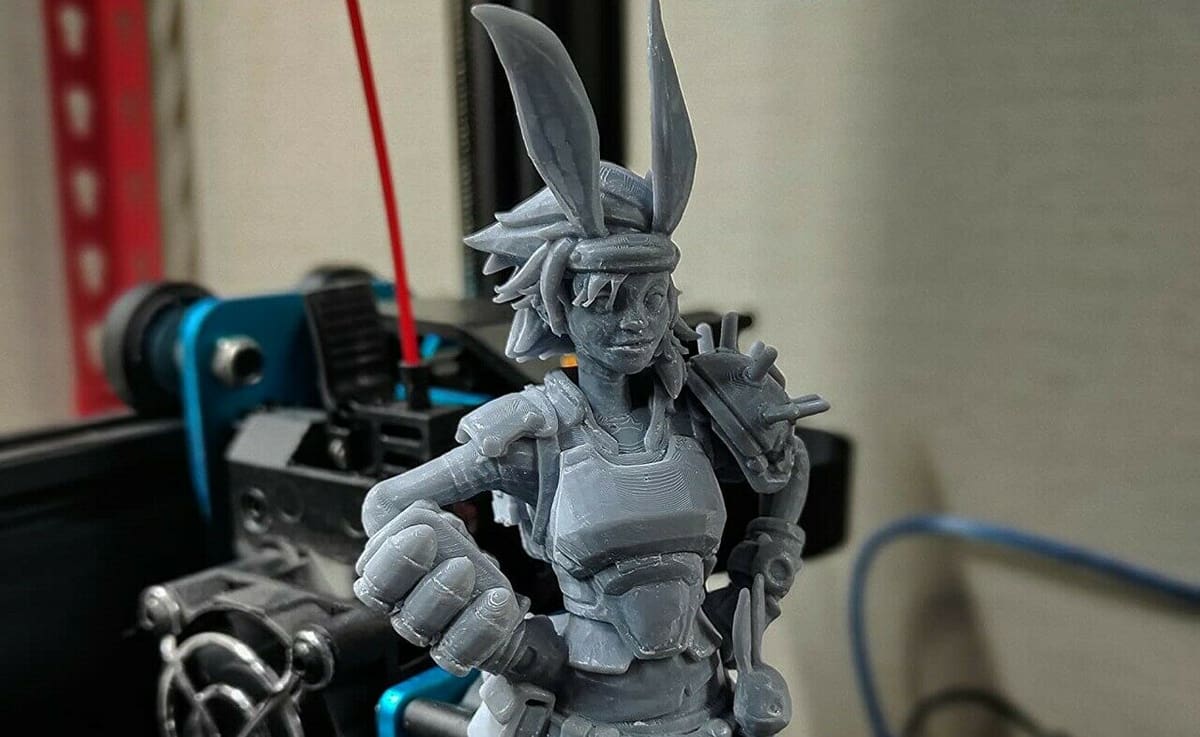
Flashforge is a 3D printer manufacturer that also produces resins. An interesting fact about Flashforge’s standard resin is that it copes with heat very well; in fact, it can handle vacuum forming, a process where a heated film of plastic is pneumatically pulled onto a 3D printed model, resulting in a plastic mold of that part.
Moreover, the level of detail it’s capable of producing is among the best we’ve seen so far from a standard resin. The strength of printed parts is also relatively high, and there’s a variety of colors available. Perhaps the only real downside is the rather intense smell, but it’s certainly not alone in that.
- Colors: White, black, red, green, gray, transparent, mint green, ice blue
- Sizes: 0.5 kg, 1 kg
- Price: ~$25 (0.5 kg), ~$40 (1 kg)
Anycubic Plant-Based

Anycubic is a close competitor of Flashforge’s, and their special eco resin is an attempt to make resins more eco-friendly and bearable to work with as far as smell is concerned – a commendable effort.
Obviously, Anycubic wouldn’t disclose the formula of its plant-based resin, but what we do know is that it has a low epoxy content, which contributes to the greatly reduced odor. However, still make sure to take proper precautions when handling and disposing of this resin. The fact that it’s called “plant-based” doesn’t take away the importance of personal safety and safe disposal of hazardous substances. Don’t throw it down the drain, but let any leftover resin cure, and then you can safely dispose of the cured block of hard plastic.
Anycubic’s eco offering is quite a versatile resin, but it doesn’t produce the highest level of detail. Otherwise, it’s definitely a recommendation for makers and the eco-conscious, although it should be noted that not all colors are available in all sizes.
- Colors: White, black, transparent green, gray, pink, blue, yellow, clear
- Sizes: 0.5 kg, 1 kg
- Price: ~$50 (0.5 kg), ~$70 (1 kg)
PrimaCreator Value Standard
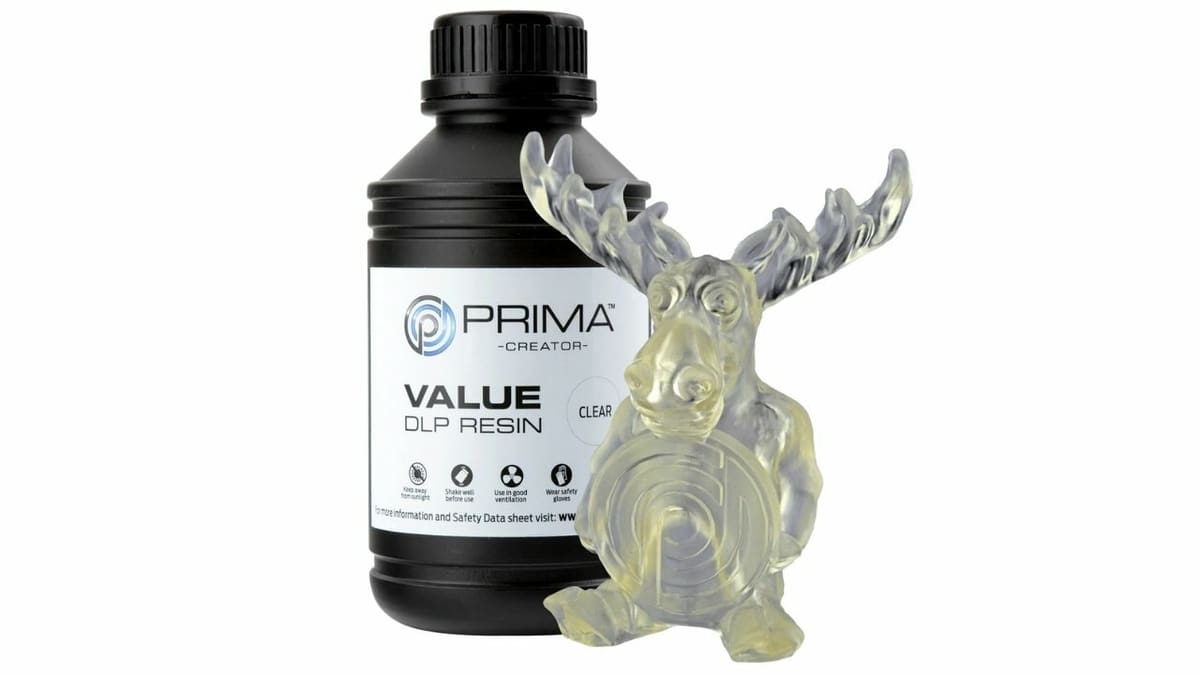
PrimaCreator Value is, as the name would suggest, good value in terms of standard resins, and it has a positive reputation among users. It’s reported to have particular success on resin-based 3D printers that operate in the range of 395-405 nm, which yours likely does.
This option comes in a range of different colors and the parts it produces are quite impressive. Of all the standard resins on the market, this particular resin performs very well in terms of capturing fine details. Sharp edges, tiny patterns, and all other details found on models meant for resin 3D printing are reproduced really well.
- Colors: Clear, white, light gray, black, beige, chromatic silver, transparent red, transparent green
- Sizes: 0.5 L, 1 L
- Price: ~$35 (0.5 L), ~$60 (1 L)
Sunlu Plant-Based Bio
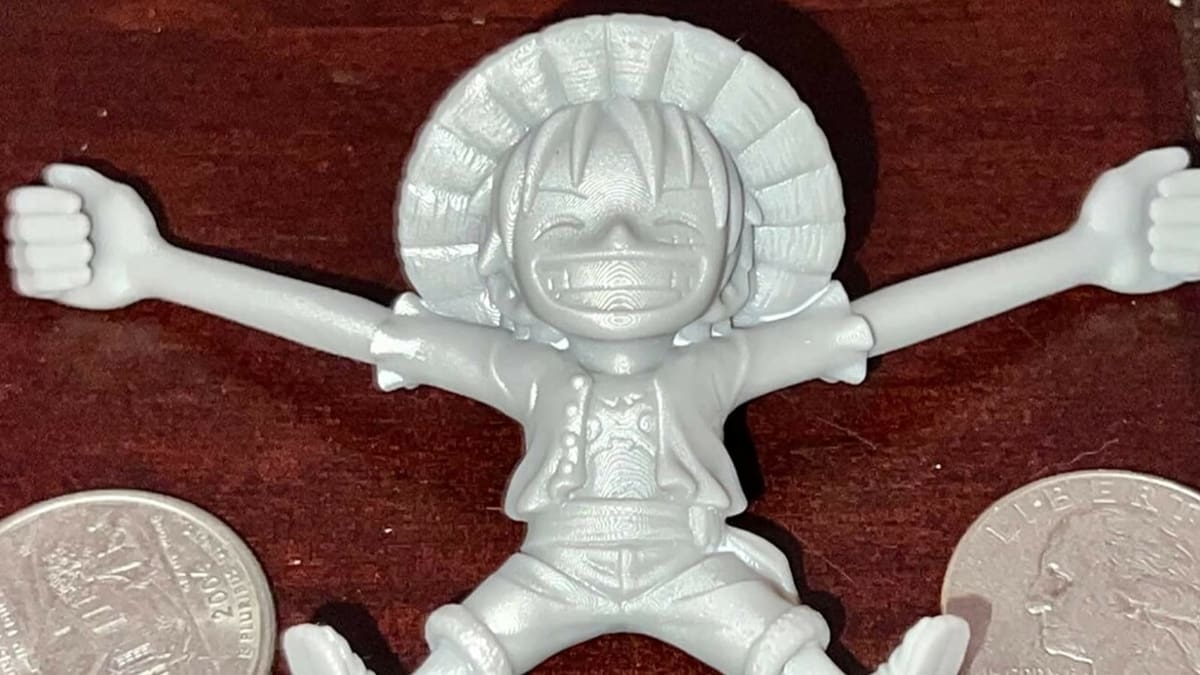
Sunlu has released its own plant-based resin derived from soybean oil which is an eco-friendly choice for your standard, day-to-day resin. It will work with most printers and reviewers mention that it doesn’t separate easily, which is nice if you only print occasionally, and its being easy to mix could be a plus for users interested in adding a bit more strength.
Most makers who opted for this resin say that it has a softer odor than other options, although a few disagree.
- Colors: Gray, clear green, black, white, dark gray
- Size: 1 kg
- Price: ~$30 (1 kg)
FunToDo Standard
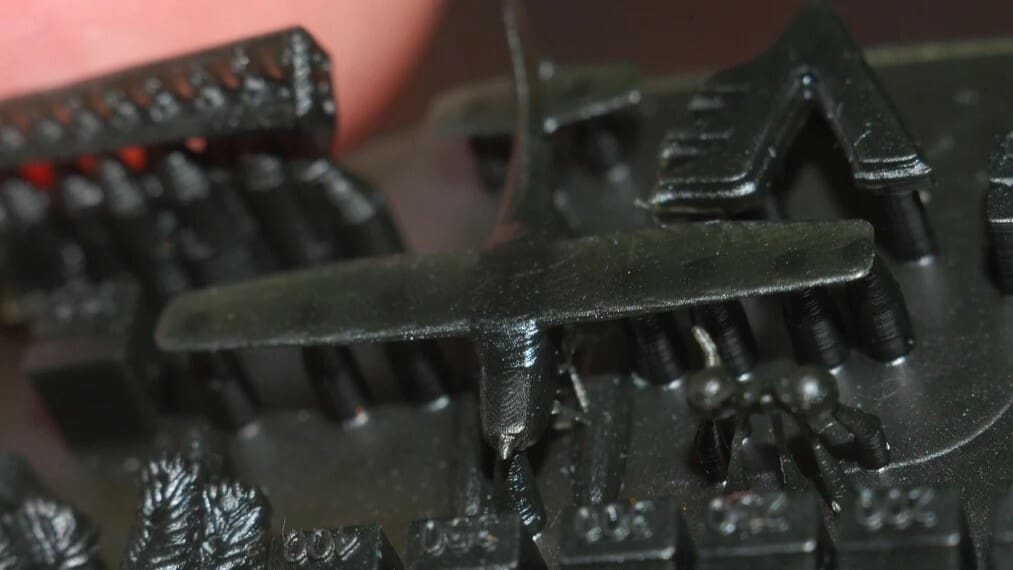
FunToDo’s standard blend resin is an option you may not have heard of but it’s definitely worth mentioning. Although it’s not one of the biggest brands, its low cost and relatively high performance make it a good option. In fact, some makers have had some prints with this resin sitting in direct sunlight for years without any noticeable degradation.
It produces highly detailed parts with vivid pigmentation, so the parts really pop. When it comes to compatibility, the resin cures on most, if not all, photopolymer printers because it can be cured at any wavelength between 225 and 415 nm. Unlike other options, the smell from this one isn’t too bad, so it may well worth be checking out.
- Colors: Black, red, unpigmented
- Size: 1 kg
- Price: ~$60 (1 kg)
Water-Washable
Water-washable resins enable you to rinse your 3D printed parts with tap water instead of alcohol, which is required by all other types of resin. As alcohol adds up to the overall cost of resin 3D printing, the water-washable options are a bit more budget-friendly as well as easier to use.
Due to a change in formula compared to standard resins, water-washable resins come with a few compromises. Firstly, water-washable resins produce more brittle parts than standard resins, which is especially noticeable with hollow prints.
While curing times don’t differ when compared to standard resins, the overall processing time might, as water-washable resins need more time to dry off before being cured. Curing with too much water left in a part can lead to even more brittleness.
Prints from water-washable will not have as great long-term stability compared to parts from standard resin. This is due to the fact that water-washable resins are eager to absorb moisture, which could weaken the parts over time.
However, if used in dry environments for the purpose of something like visual prototypes, water-washable resins are a valuable tool, as it saves you the hassle of dealing with alcohol in the printing process. And the smell can even be a little less intense than that of standard resins.
We can’t stress this enough, but please remember not to rinse parts made with water-washable resin in your sink. The residual resin is still hazardous and should not be washed down the drain. Instead, learn how to dispose of resin in a safe manner.
With all of the above in mind, let’s take a look at our choices for best water-washable resins.
Ministry of Resin

This water-washable resin from Ministry of Resin gained popularity among makers based on a number of positive reviews. What’s perhaps most noticeable is the strength this resin imbues in parts. Often, water-washable prints can be prone to cracking, but that doesn’t seem to be an issue with Ministry of Resin’s.
New and modern resin 3D printers come with monochrome screens, which allows them to cure resin faster. Because this resin is specifically tailored to work well with mono screens, it’s also able to provide fast curing times.
- Colors: Gray, translucent quartz, translucent ruby red, translucent ocean blue, translucent emerald green
- Sizes: 1 kg, 1 gal
- Price: ~$50 (1kg), ~$190 (1 gal)
Elegoo

Elegoo’s water-washable resin is another popular choice due to its performance. It’s only a little more brittle than the standard Elegoo resin, but it still produces nice, detailed prints, and cleans very well with water. It might seem strange to point out, but the effectiveness of water-washing parts does vary, so it’s an important aspect to take into account.
In terms of surface quality, this resin produces surfaces that feel rubbery, and there are nine colors to choose from. Overall, this resin offers great quality at an affordable price, which is why it’s a popular choice among hobbyists.
- Colors: White, gray, black, smoky black, beige, yellow, clear blue, clear green, clear red, mint green
- Sizes: 0.5 kg, 1 kg
- Price: ~$20 (0.5 kg), ~$35 (1 kg)
eSun
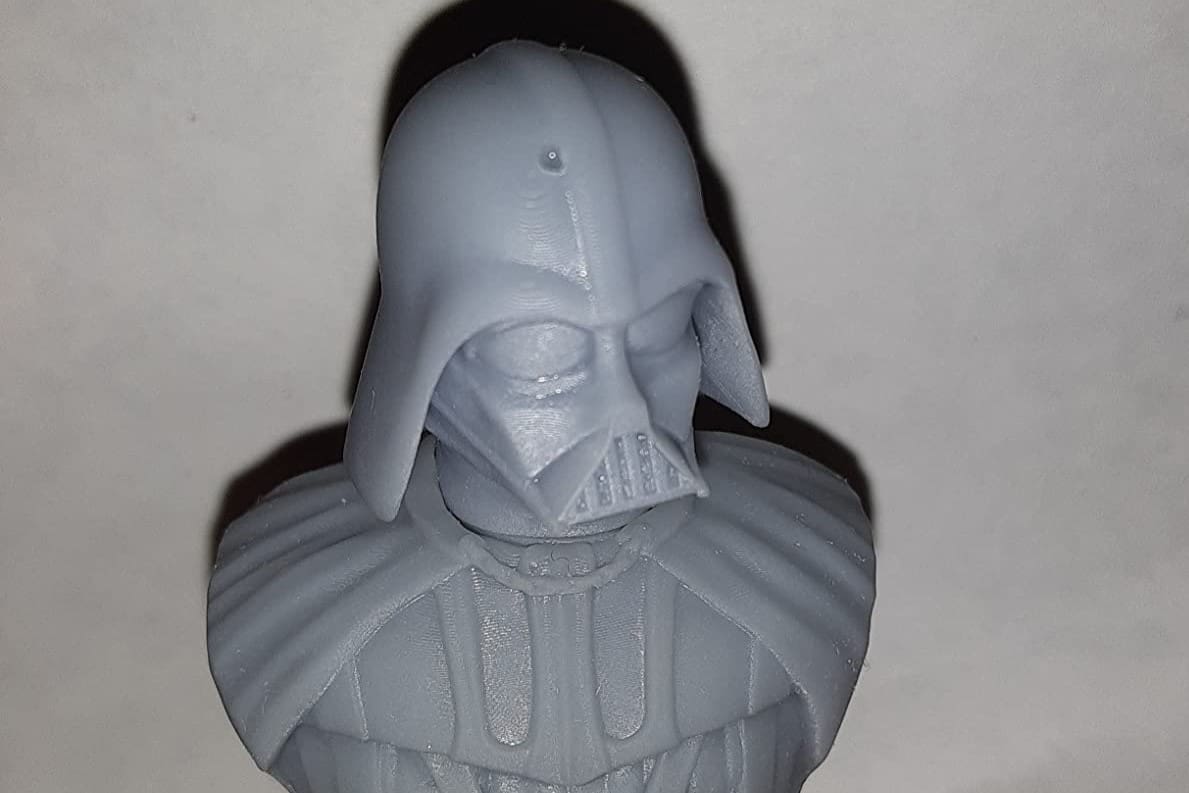
At first sight, eSun’s water-washable resin feels quite premium due to its aluminum bottle, which comes with an inner plug that prevents leaking when pouring the resin. Yet the fancy packaging contains an affordable product that’s just as easy to work with as its competitors.
Models made with this resin have a nice, vibrant color. When it comes to details, we’d say that’s where this resin truly shows its quality. It’s worth noting, though, that similar to the Elegoo resin, the models are a bit brittle.
Sometimes, it might be difficult to find eSun’s resin in stock, but if you’re planning on making detailed models for painting and don’t want to use alcohol for cleaning, this resin is a strong contender.
- Colors: Beige, gray, white, black, transparent, yellow, orange
- Size: 0.5 kg
- Price: ~$30
Sunlu

Sunlu’s water-washable resin is a fast curing option that’s also compatible with 8K printers and comes in at a very competitive price. It may be slightly more brittle than the brand’s standard resin, but the fact that you don’t need to wash it with alcohol can be a big advantage for people printing models at home.
Its competitive price, positive Amazon reviews, and high resolution capabilities have earned it a spot in this article.
- Colors: Gray, black, white, dark gray, beige
- Size: 1 kg
- Price: ~$30 (1 kg)
Tough
Tough resins are the ultimate choice when it comes to creating functional parts. What makes them worthy of such applications is their tweaked formula, which includes additives that contribute to the structural strength of the polymer.
It’s usually possible to drill into the models printed with tough resin without a major risk of cracks occurring, which is practical for post-processing applications that incorporate threaded inserts. The tougher surface is also more suitable for sanding without damaging the part.
Considering tough resins are aimed toward the professional and industrial side of resin 3D printing, the price per volume is higher than it is for standard resins. Also worth noting is how tough resins tend to have a slightly more intense smell when compared to other resins due to their formulation.
With all the above in mind, let’s take a look at our top picks for tough 3D printing resins.
eSun Hard-Tough
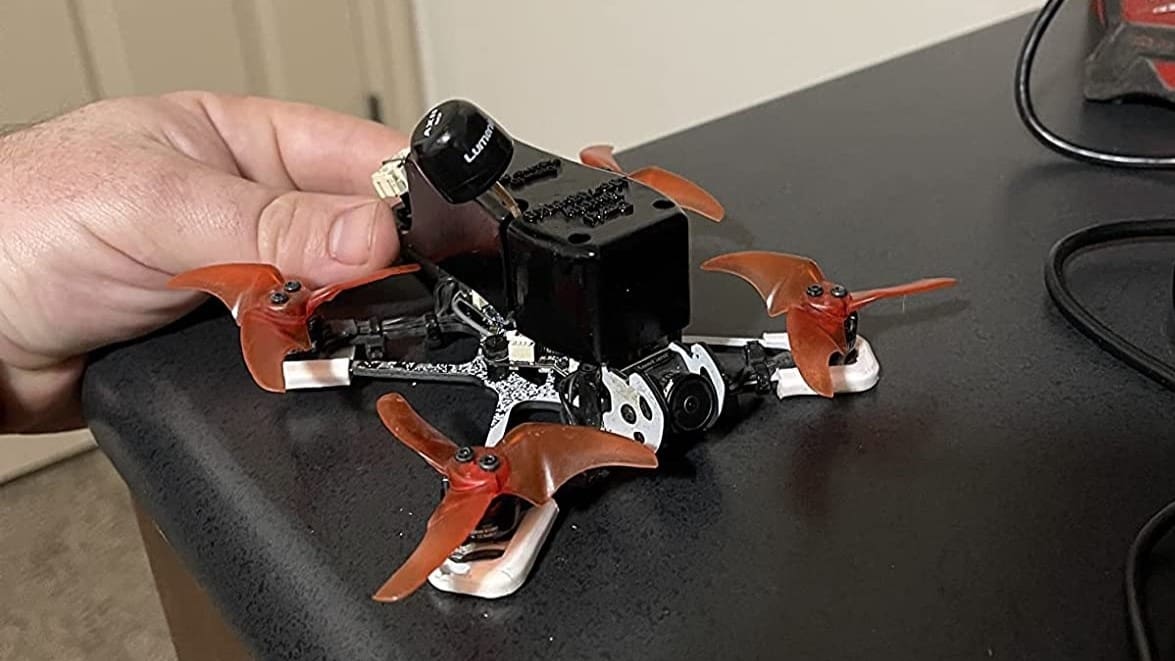
eSun’s Hard-Tough resin is ideal for making functional parts, as it provides properties such as rigidity and wear-resistance. It can even handle holes being drilled into cured parts.
Models printed with standard resin can lose their shape if exposed to certain elements. eSun’s Hard-Tough resin creates stiffer parts that can take more wear without compromising their initial dimensions. There’s also a reduced risk of fractures on thinner areas of the parts, due to the resin itself being quite a rigid polymer mix.
Its great properties and competitive pricing make it an interesting option for people looking for a quality, industrial-grade resin.
- Colors: Blue, black, white, gray
- Sizes: 0.5 kg, 1 kg
- Price: ~$50 (0.5 kg), ~$80 (1 kg)
Voxelab ABS-Like
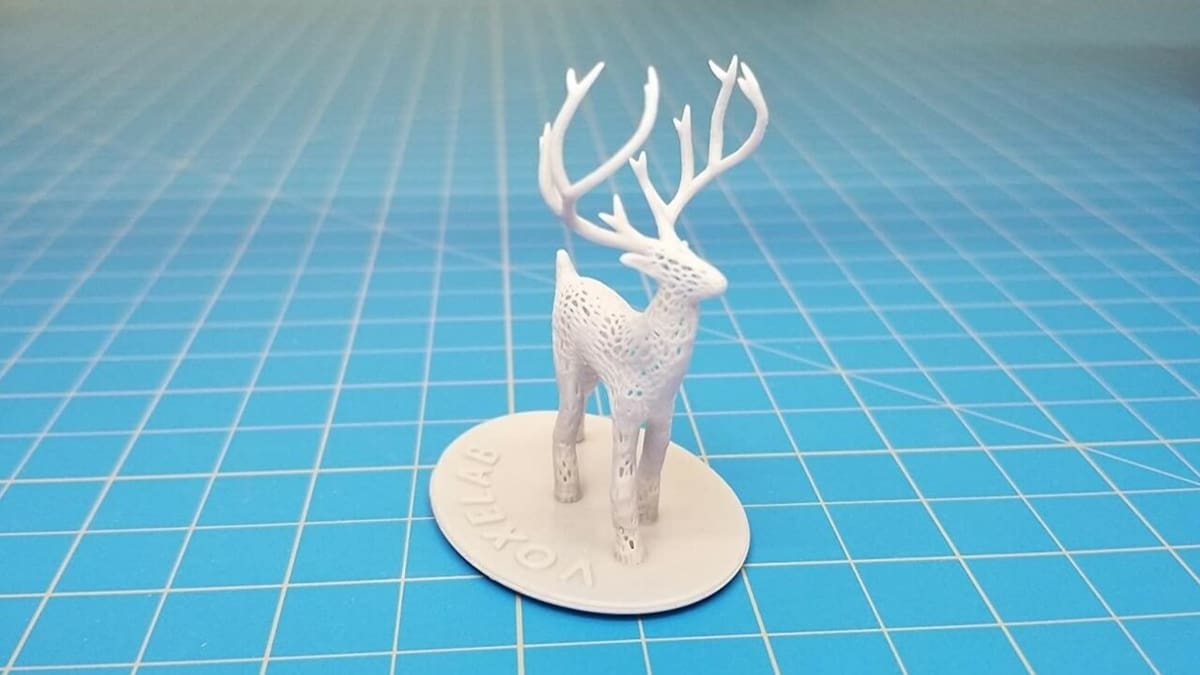
Voxelab’s ABS-like resin is designed to be easy to paint, so they likely had visual model print jobs in mind when they formulated this popular resin.
Voxelab mentions that the material has been designed to have low shrinkage, something that reviewers note, and that it’s also easier to remove from the print bed, as this can be a challenge sometimes.
Settings may need to be tweaked though, but once they’re the right ones, this resin may just be offering some of the best results possible.
- Color: Gray
- Sizes: 0.5 L, 1 L
- Price: ~$15 (500 ml), ~$28 (1 kg)
Liqcreate Strong-X
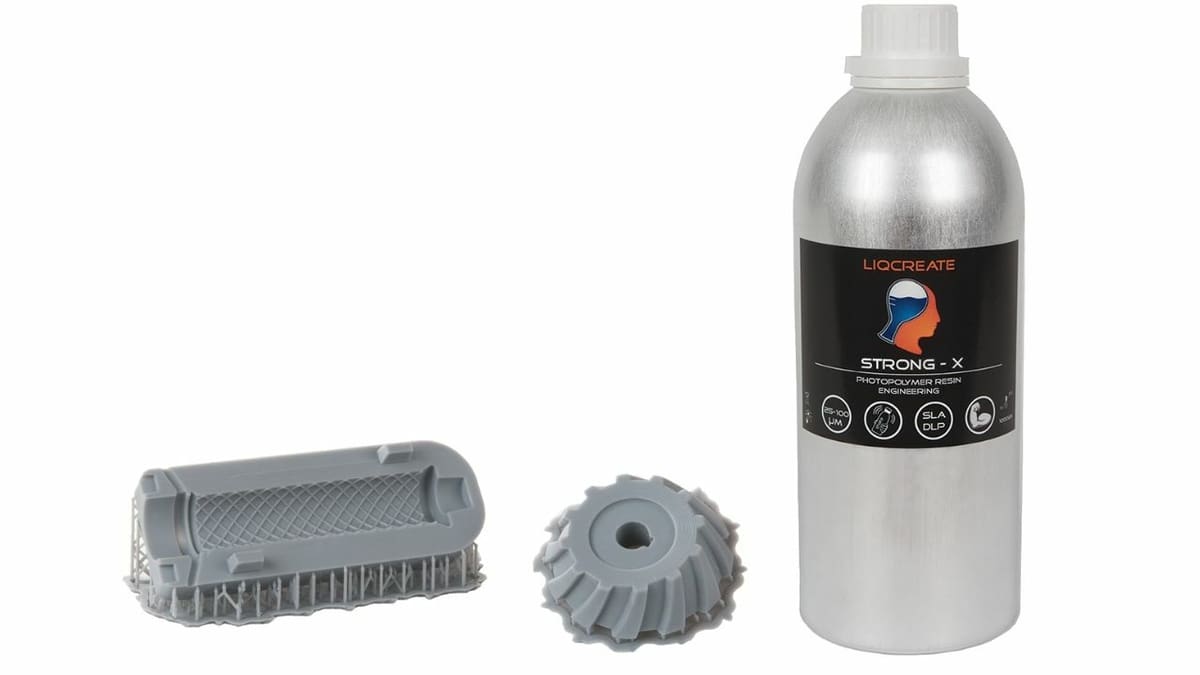
Liqcreate’s Strong-X resin is one of the strongest on the market, with its impressive claimed flexural strength of 135 MPa. The resin is compatible with printers generating wavelengths in the range of 385-405 nm, which most hobby printers do. This will work with most LCD and DLP machines, as well as with some SLA printers.
This resin is definitely made for those who take 3D printing more seriously, such as advanced hobbyists and professional users. While it has a higher price tag when compared to other options, depending on the use intended for the prints, it may just be worth it.
- Color: Gray
- Sizes: 250 g, 1 kg
- Price: ~$60 (250 g), ~$160 (1 kg)
Henkel Loctite 3843 HDT60
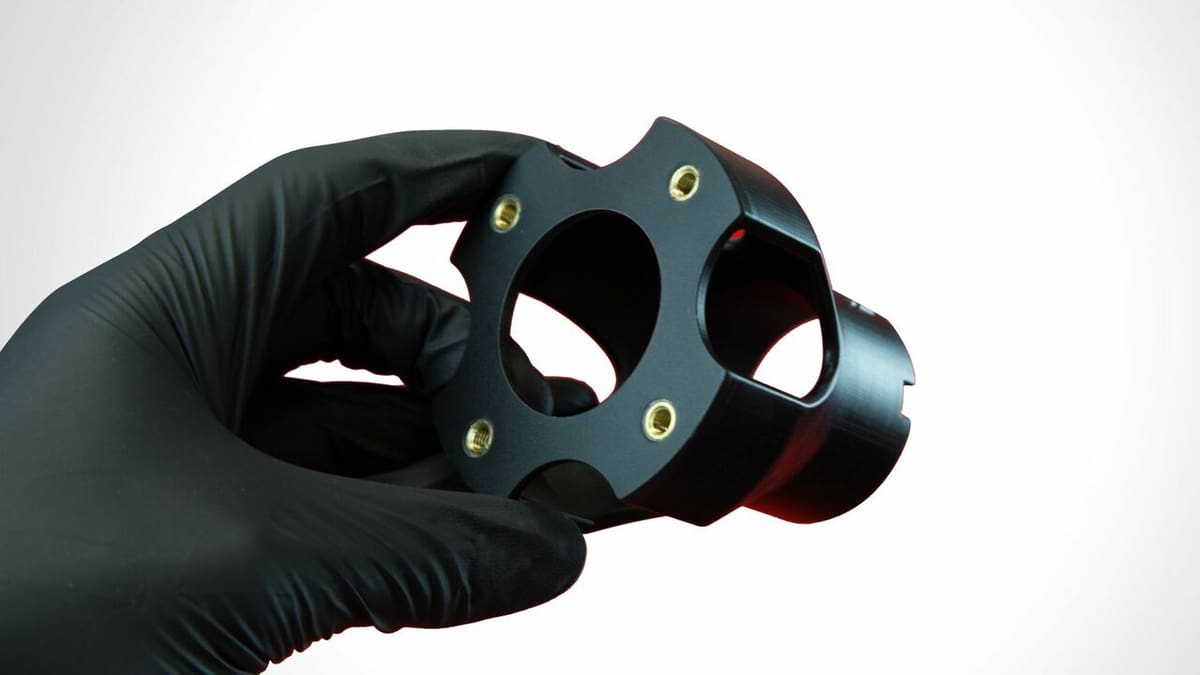
This is a very tough, engineering-grade material with an excellent surface finish. Although it’s on the more expensive end of resins, the results are fantastic and almost look like injection-molded parts.
Although it’s one of the toughest resins on this list, its price puts it slightly out of the reach of most hobbyist budgets.
Having similar characteristics to ABS (used in FDM 3D printing), this material is used for tooling or consumer product applications. It has a Shore hardness of 68D and good heat deflection properties.
- Colors: Black, gray, white, clear
- Sizes: 1 L, 5 L
- Price: ~$230 (1 L), ~$1,100 (5 L)
FunToDo Industrial
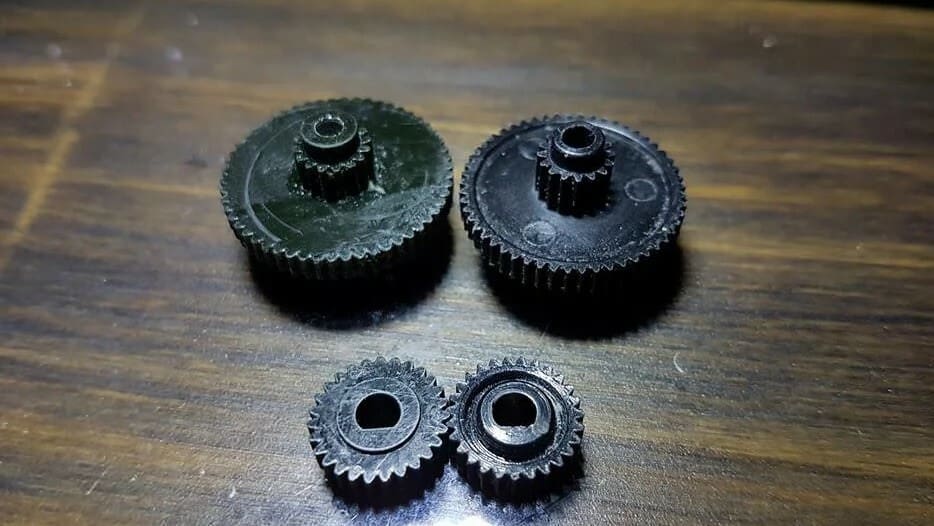
FunToDo’s industrial resin offers probably one of the best values on this list. It provides low cost and high performance, particularly in terms of its ability to withstand high and low temperatures between -45 and 225 °C (-49 to 437 °F).
Due to its toughness, it can usually be printed a bit faster than their standard resin, and it’s ideal for industrial applications or anytime you need a strong part. It has a Shore hardness of 75D, similar to a builder’s hard hat, and can be used to directly cast low melting temperature metals like pewter or tin, so it enables additional processes after printing.
Due to the similarity in cost, going straight to this resin rather than FunToDo’s standard option may be the way to go if you’re only opting for one.
- Colors: Red, black, unpigmented
- Size: 1 kg
- Price: ~$60 (1 kg)
Draft
With the nature of resin 3D printing, the type of resin can have an effect on the overall print time. This is due to the fact that resins have different curing times, with shorter curing times saving a lot of time in the printing process. Draft resins are specifically optimized for fast printing.
The name “draft resin” was initially introduced by Formlabs, which we’ll get to later, while other manufacturers use different naming, such as “rapid resin”. These resins are formulated so that the curing process can take as little time per layer as possible. Thicker layers can also contribute to lowering the print time, so some draft resins are also designed to print larger layers successfully. This is very practical for applications such as product development where prototyping requires a number of design iterations until the shape is finalized.
In case you’re wondering about the smell of draft resins, it’s usually not as bad as that of tough resins; it’s quite similar to the moderate intensity of standard 3D printing resin.
Keep in mind that draft resins don’t just lack the strength of other resins, they lack the stability too. So they’re not suitable for model making as they will almost certainly deform over time. We’ve had draft resins completely deform after just one day, so stick to using them to confirm your models are correct before printing the definitive version in another material.
Before you take your prototyping workflow to the next level with draft resin, let’s take a look at our top choices.
Siraya-Tech Fast

As Siraya-Tech’s website claims, this fast resin is a good choice for a general-purpose resin. It’s not brittle, yet prints quickly, making it a strong choice for all prints except those with very specific requirements for part properties (like stiffness or heat resistance).
Reviews are overwhelmingly positive, especially noting the high print quality and the level of captured detail. Prints have shown that it’s not brittle either. In fact, some users have reported that it’s among the strongest when it comes to fast resins.
The available color palette isn’t the most varied, but there’s a good choice of monochrome shades. And while there used to be reports of leaky bottles, Siraya has reportedly fixed the issue.
Taking the price into account as well as the resin’s performance, this option offers quite a good compromise. Just note that not all colors are available in all sizes.
- Colors: Gray, navy gray, white, creamy, smoky black, mecha white, metal gray
- Sizes: 1 kg, 5 kg
- Price: ~$40 (1 kg), ~$155 (5 kg)
Anycubic
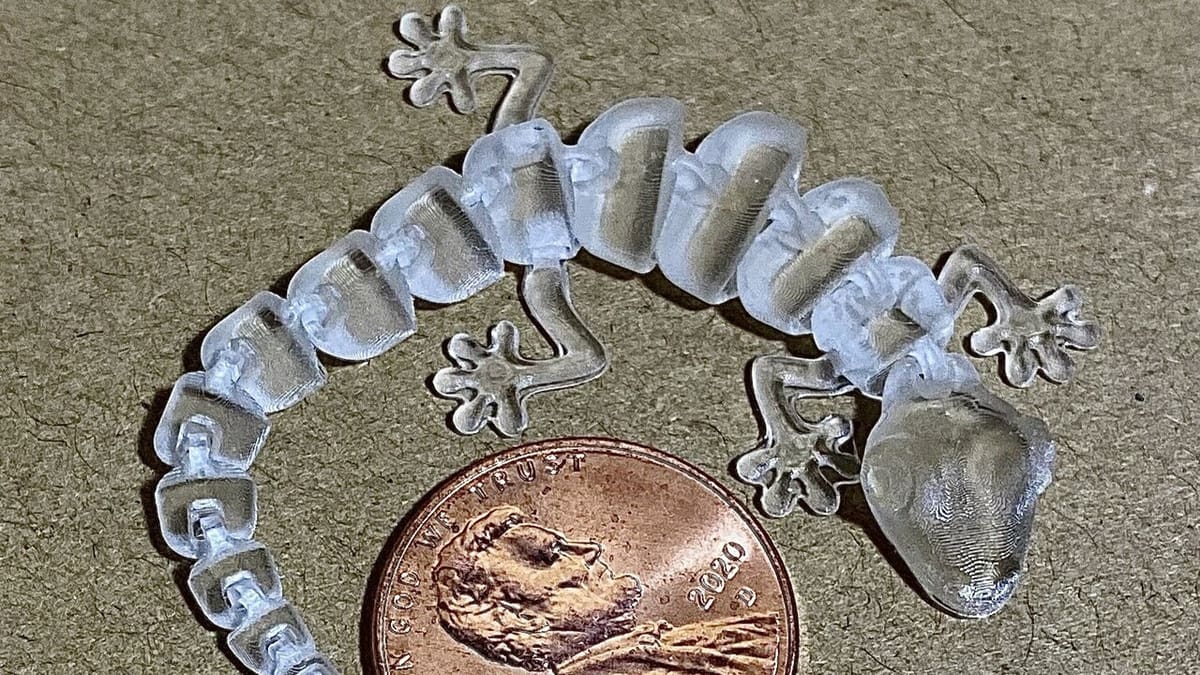
Anycubic’s Colored UV resin, while technically not draft, has a lot of positive Amazon reviews and comes in at great value for a resin that is so low cost.
A distinction between these resins is the quality of the pigmentation, and Anycubic’s resin scores well in this department.
This resin has 2-second cure times on many hobby printers, so it’s a good option if you just want bright, colorful prints, quickly.
- Colors: Blue, black, clear, clear green, beige, gray, white
- Sizes: 0.5 kg, 1 kg
- Price: ~$15 (0.5 kg), ~$35 (1 kg)
Monocure3D Rapid
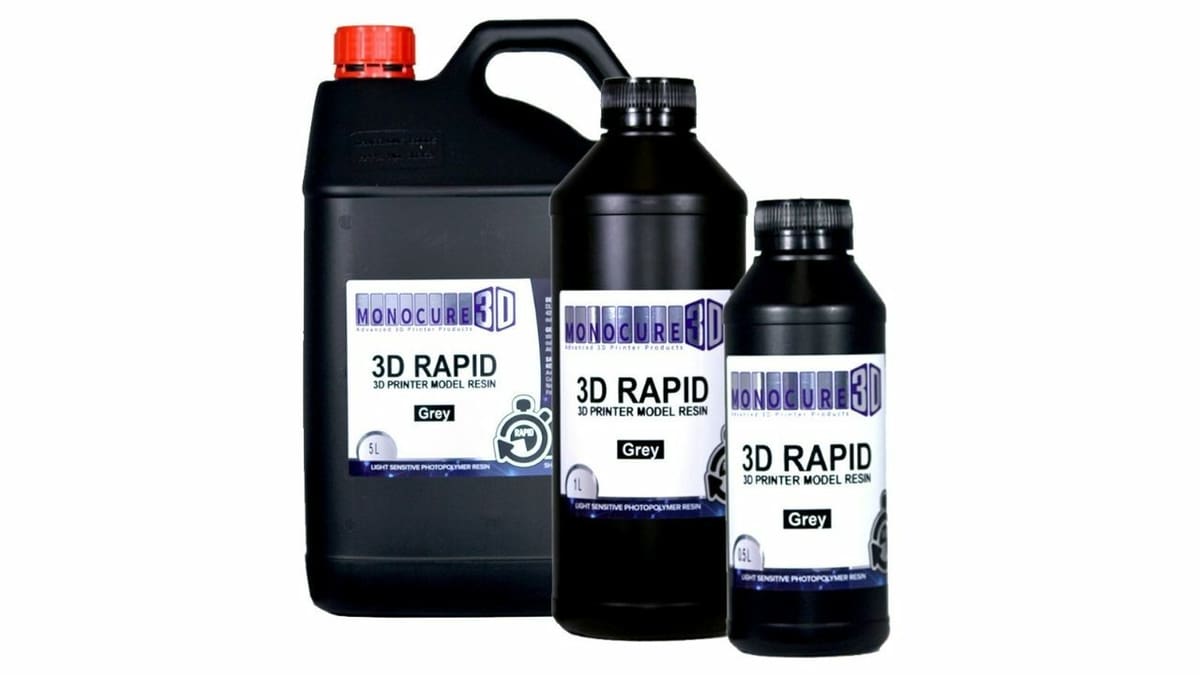
Monocure3D’s rapid resin is available in different sizes, and perhaps more importantly, colors. It works with popular LCD printers, especially low-powered and monochrome LCD 3D printers.
You can expect to see curing times of around 2.5 seconds with this resin, which is somewhere around the usual curing time for the majority of currently available rapid resins.
Many people find this to be one of the best rapid resins on the market due to how easily it prints, reliably and consistently producing stunning results. All things considered, this is definitely a strong contender, especially for hobbyists.
- Colors: Black, blue, clear, green, gray, red, white, gunmetal
- Sizes: 0.5 L, 1 L, 5 L
- Price: ~$40 (0.5 L), ~$70 (1 L), ~$250 (5 L)
Flexible
There has been a lot of development in flexible resins in the last few years, and flexible resin prints have even made their way into consumer products like running shoes, bike saddles, drinking bottles, and even basketballs as showcased recently by Carbon. These resins usually specify how hard they are and tend to be quite tough due to their, well, flexibility.
Flexible resins try their best to mimic rubber. Parts made with flexible resin need to be durable, with the ability to withstand force and return to their initial shape. An important measurement for flexible resins is their hardness, measured on the Shore scale. The majority of flexible resins are rated somewhere around 80A Shore hardness but there is some variety in the market. Think of 80A as that of a solid rubber midsole.
There are some resins rated lower down the Shore scale – these are trying to mimic materials such as silicone. They’re a bigger struggle to print, considering the unique properties, but tweaking the settings around what the manufacturers suggest should get you to success. Just remember that when designing parts for flexible resin, you should always print the parts in their intended shape.
In spite of the material’s flexibility, it’s not meant for objects to be reshaped after printing. If you’re looking to 3D print lots of colored models with flexible resins, you may be disappointed by the fact that most flexible resins are limited to neutral or basic colors.
What’s not so impressive is the smell of flexible resins, which is often compared to that of tough resins. Bearing all that in mind, let’s take a look at our top picks!
Monocure3D Flex
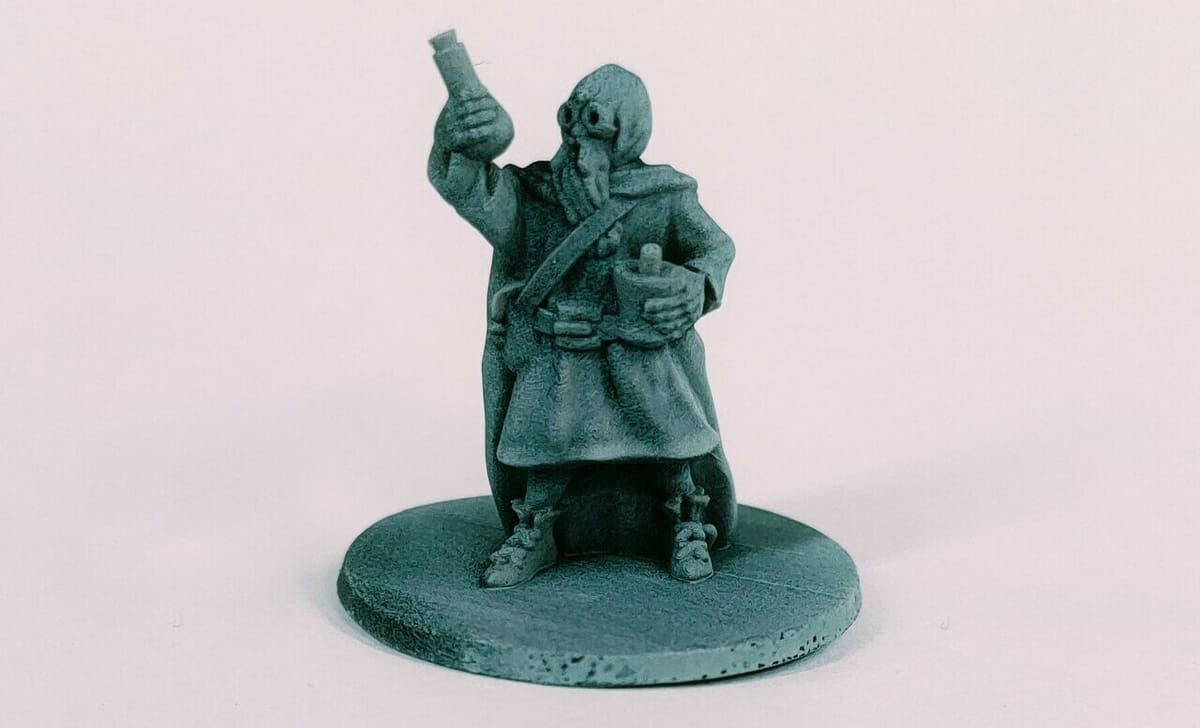
Monocure3D has already appeared on our list for an impressive fast resin, and they’re back with a quality flexible resin at a competitive price.
It’s quite cool to see that Monocure3D goes as far as providing instructions on how to mix this resin with their rapid resin in order to gain specific part properties. The mixture is possible thanks to the low viscosity of the flexible resin and will give your models more durability while retaining the rapid print time.
On its own, this resin produces models with quite some flexibility; it’s just a matter of trying the best settings that work for your design and its intended use.
- Colors: Blue, clear
- Sizes: 0.5 L, 1 L, 5 L
- Price: ~$65 (0.5 L), ~$120 (1 L), ~$450 (5 L)
SuperFlex
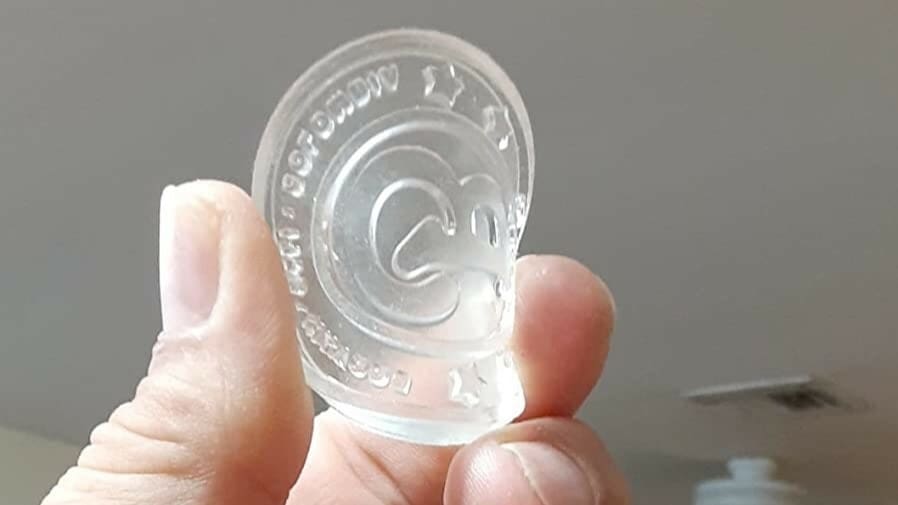
3DMaterials has created a very flexible material with a shore hardness of 80A, and it’s name makes the claim quite obvious.
Considering it’s a flexible material, it has very low viscosity, something that makes it suitable for a wide variety of hobbyist printers. Its ability to withstand a 150% elongation makes it ideal for wearables and parts that will see lots of use. Another nice point is that it can be mixed with their non-flexible materials to create the feel that you need. All in all, it’s definitely worth a look for your next flexible project.
- Color: Clear
- Sizes: 0.5 kg, 1 kg, 5 kg
- Price: ~$30 (0.5 kg), ~$60 (1 kg), ~$265 (5 kg)
Prusa Flex80
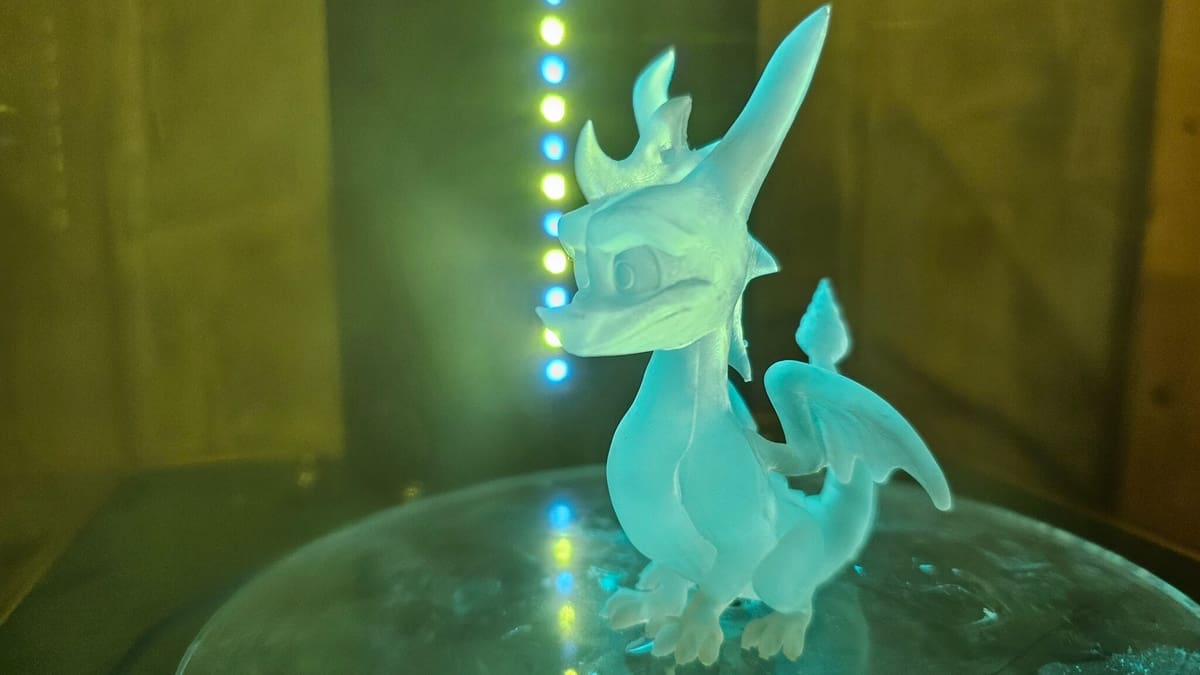
Prusa may be best known for its place in the FDM world, with 3D printers like the i3 MK3S, Prusament filament, and PrusaSlicer, but the company has also been taking to the resin 3D printing market.
Starting in 2019 with the SL1 and following up two years later with tough resins, in late 2022 it was the time for the Flex80.
With a Shore hardness of 80A and available in two colors, this material, while made with the SL1 in mind for best results, is still compatible with non-Prusa machines. And users appear to be more than satisfied with their results, with comments on the company’s site including a suggestion to mix it with a bit of “Tough” resin for more resilience.
- Colors: Black, transparent
- Size: 1 kg
- Price: ~$70
8K
As the resin 3D printing market moves forward at a fast pace, the resolutions of screens fitted to LCD 3D printers are rapidly increasing. The first 4K resin printers have been available for less than two years, and we’ve already moved onto the so-called 8K resolution (referring to the approximate number of pixels across the width of the screen).
The terms 4K and 8K sound impressive and serve as a great resource for marketing material, and the same is true for 8K resins. If you don’t have an 8K machine, the quality produced by these resins won’t necessarily be superior to that of any other. Instead, manufacturers who offer such resin have simply tweaked them to work optimally with 8K 3D printing hardware.
In the following paragraphs, we’ll present the two most popular 8K resins which come from Elegoo and Phrozen, who both produce dedicated 8K resin printers as well.
Phrozen Aqua 8K
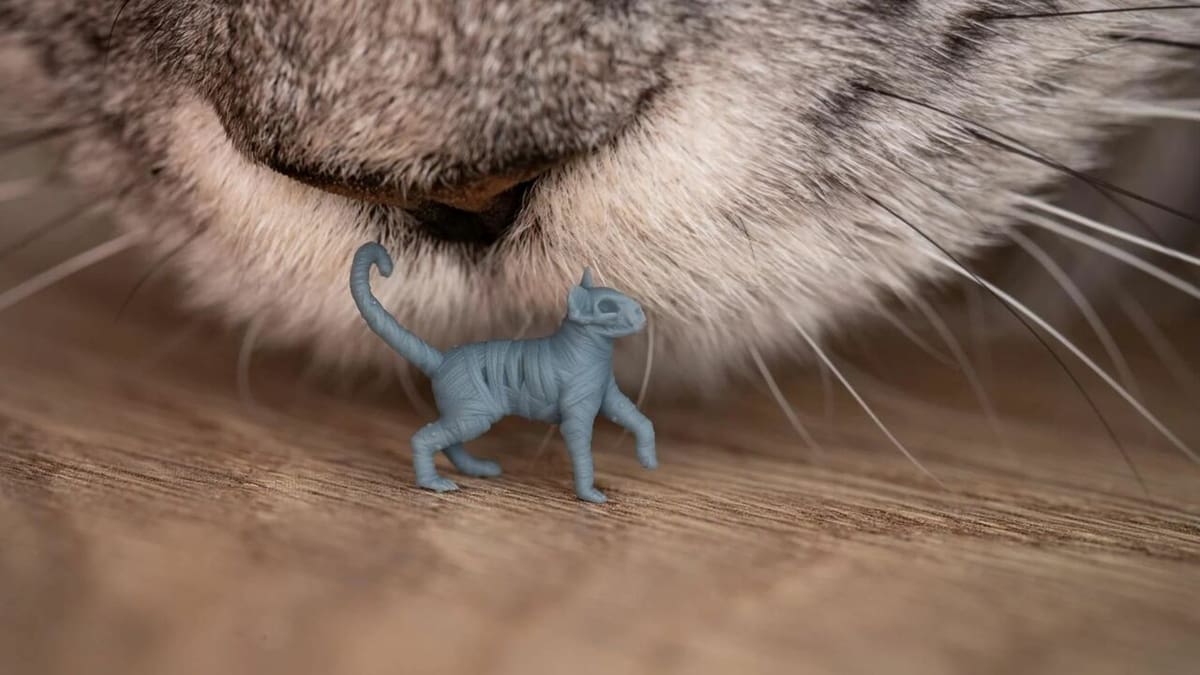
Phrozen developed the Aqua 8K resin specifically for its Sonic Mini 8K. It’s just a standard resin, but tweaked to get the most out of the powerful 8K hardware that Phrozen integrates into their 3D printers. Users report a visible improvement in the level of detail over 4K resins.
Even if you don’t own an 8K printer or if your machine is from another manufacturer, you can still use this resin and it won’t disappoint. The price tends toward the higher end, but considering the positive review, it might just be worth it!
- Colors: Gray, vanilla, red clay, snow gray
- Size: 1 kg
- Price: ~$40
Elegoo 8K
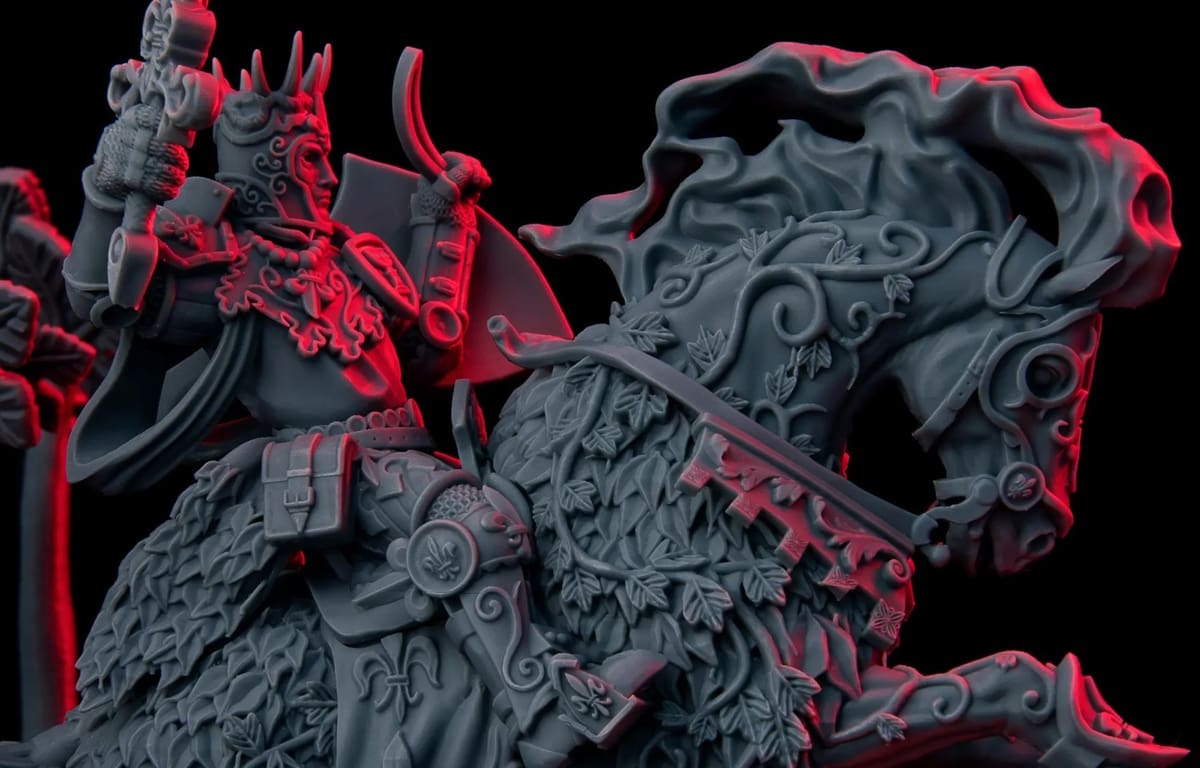
Elegoo has applied a similar principle to Phrozen when it comes to 8K resin. That is, they’ve developed it to best suit their own machines, but it’s still possible to use it on other printers.
However, the difference is that Elegoo also offers a water-washable version of its 8K resin, which is a nice option to have.
What’s noticeable about both versions of Elegoo’s 8K resin is the effect of its low viscosity. FEP films tend to last longer when used with low-viscosity resins, as prints don’t stick as hard and therefore don’t damage the surface when removed.
- Color: Gray
- Size: 1 kg
- Price: ~$40 (standard), ~$50 (water-washable)
SLA
After going over different types of resins that are best suited for LCD and DLP printers, we’ll take a look at a few Formlabs options that may be what you’re looking for in terms of best compatibility with an SLA machine.
Formlabs is a well-known US-based manufacturer of industrial SLA 3D printers. Naturally, they’ve developed their own portfolio of resins, which turned out to be incredibly impressive.
Formlabs Tough 2000
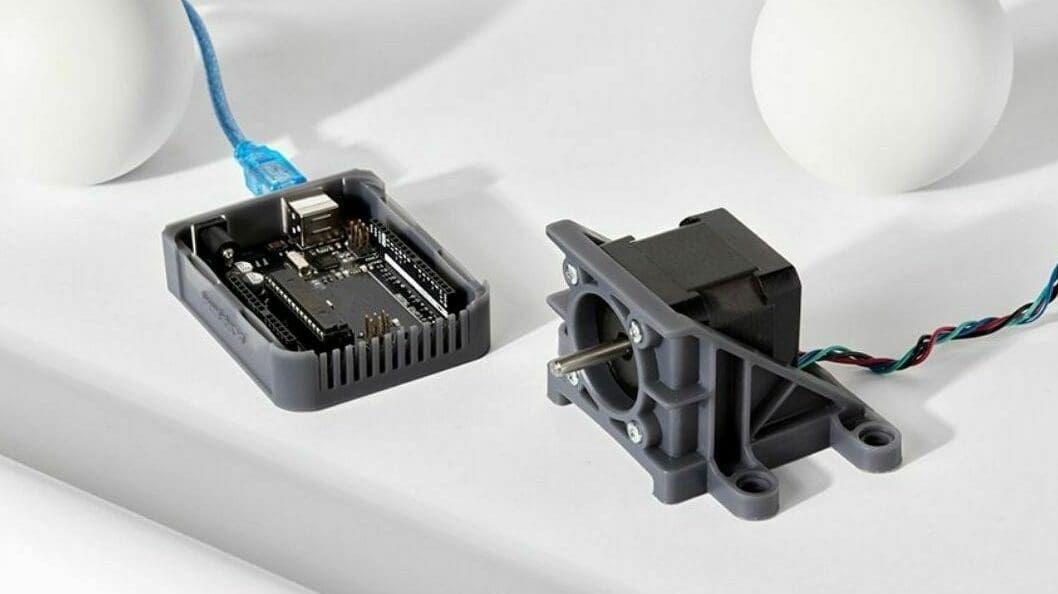
In Formlabs’ family of tough and durable resins, their Tough 2000 resin is said to be the strongest offering. The Tough 2000 resin is comparable to ABS, meaning it’s strong and doesn’t break easily. These properties make this resin ideal for functional prototypes.
The only slightly negative side of this resin is that it causes significant wear to the resin tank. Therefore, it requires frequent tank exchanges, ideally every 2-3 months if you’re printing often, which is something to consider because of the related expense and hassle. It’s also reported to be incompatible with the tanks of the Form 2 and 3 V1.
Keep in mind that this resin has exclusively been designed for use on Formlabs’ printers, but it can be, in theory, used on other SLA machines. If you choose the latter, be prepared to tweak print settings and iterate over a few test prints until you get satisfactory results. It’s also important to know that the hardware, such as the tanks of other printers, might not be suited for this resin, so if you don’t have a Formlabs machine, you may have an increased cost when it comes to such consumables.
- Color: Gray
- Size: 1 L
- Price: ~$200
Formlabs Draft
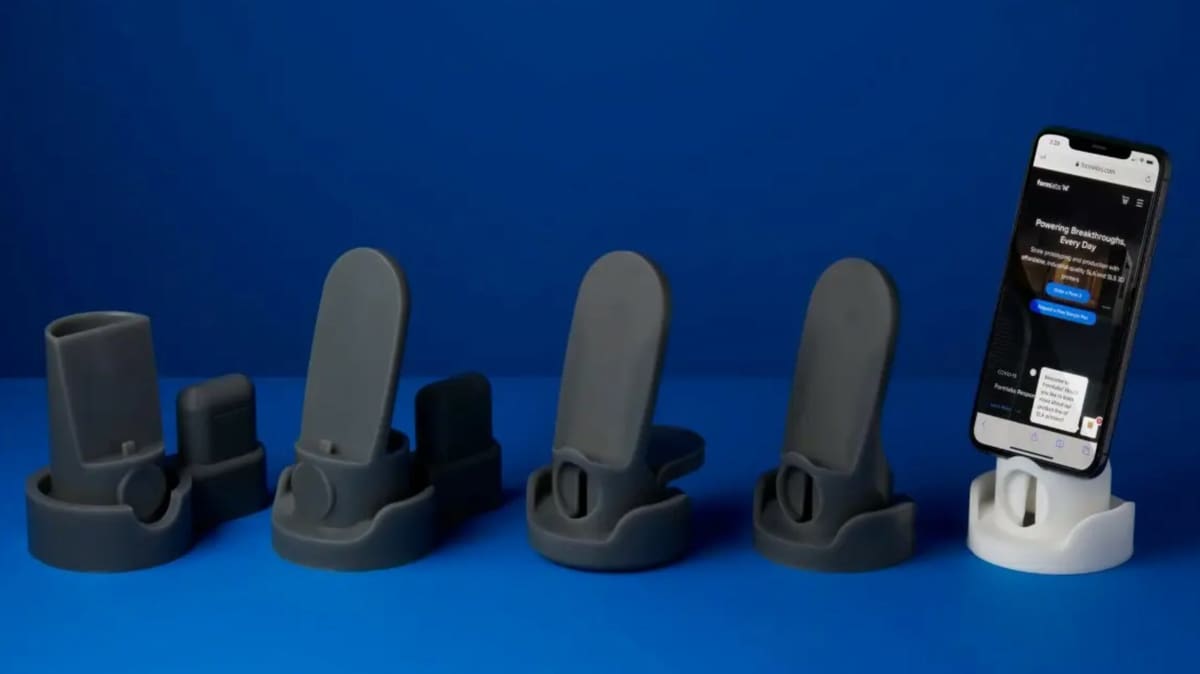
If it’s not strength but speed you’re after, Formlabs created this resin in response to the need to speed up the printing process in applications such as rapid prototyping.
Formlabs have gone ahead and re-formulated their resin to create one that allows for much shorter curing times, therefore significantly reducing the overall print time. With this tweaked formula, there are a few compromises, such as strength and detail, but for the purpose of prototype iterations, it’s nearly perfect.
Formlabs claims this resin can cure up to three times faster than its other resins, which is quite a significant figure. It’s also been designed for printing at larger layer heights, which helps reduce the overall print time.
While this resin was made specifically for Formlabs printers, it should still work with other printers, although it’s always best to check possible compatibility against the manufacturer’s guide. The cost is what sets it apart from hobbyist projects, as it’s designed for businesses.
- Color: Gray
- Size: 1 L
- Price: ~$150
Formlabs Flexible
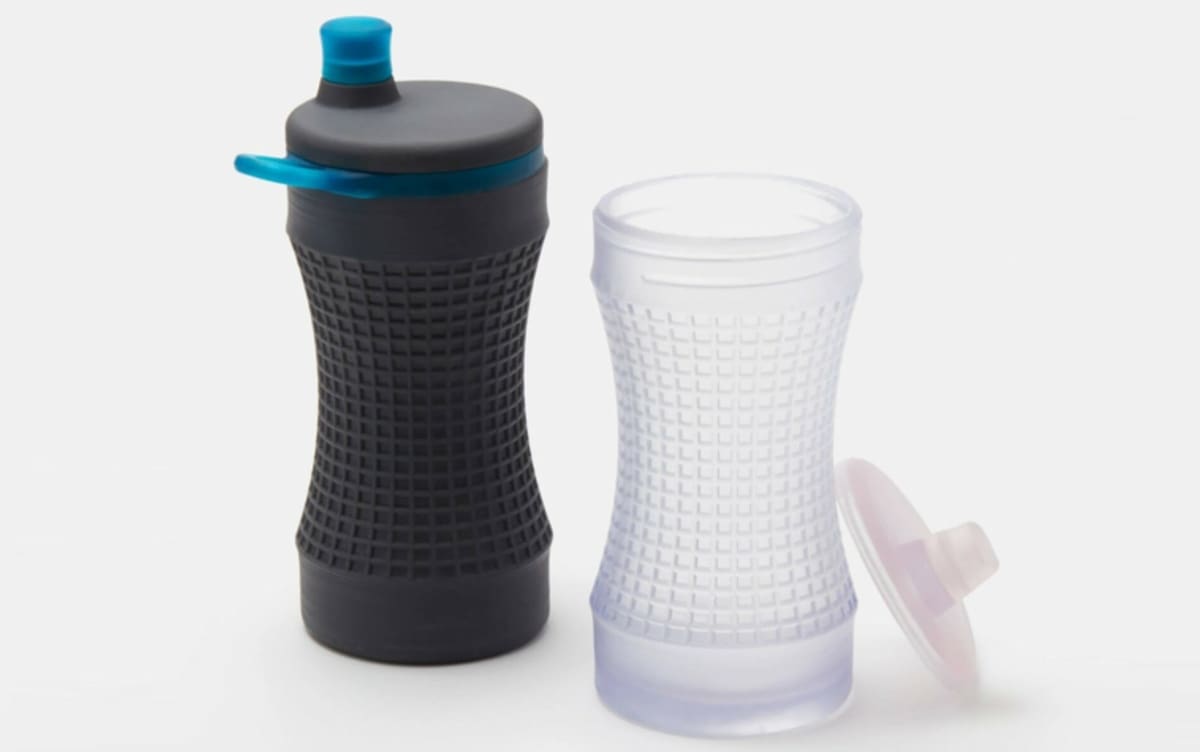
When it comes to flexible resins, Formlabs offers two choices.
The Flexible 80A is a fairly stiff resin but soft to the touch. Models printed with this resin have the feel of very rigid, hard rubber, which is ideal for applications such as grips, handles, gaskets, and so on.
The Elastic 50A, on the other hand, is a soft, flexible resin, meaning that parts made with it resemble silicone. This resin has big potential in the area of wearables, such as shoe soles and masks.
As with any other Formlabs resin, the results are of a very high standard. In case you’re not a Formlabs printer user, keep in mind that this resin is officially intended for Formlabs printers, limiting compatibility with other machines, though you can always experiment on your own printer.
- Color: Clear
- Size: 1 L
- Price: ~$200
License: The text of "The Best Resins for 3D Printers – Buyer’s Guide" by All3DP is licensed under a Creative Commons Attribution 4.0 International License.
CERTAIN CONTENT THAT APPEARS ON THIS SITE COMES FROM AMAZON. THIS CONTENT IS PROVIDED ‘AS IS’ AND IS SUBJECT TO CHANGE OR REMOVAL AT ANY TIME.

